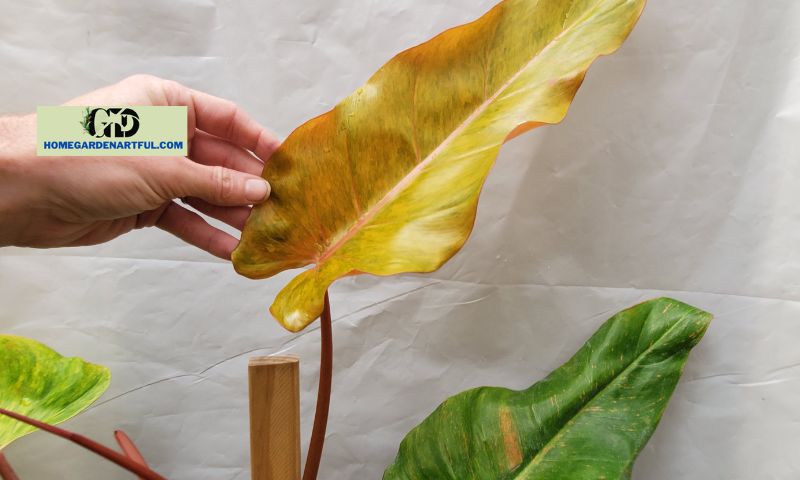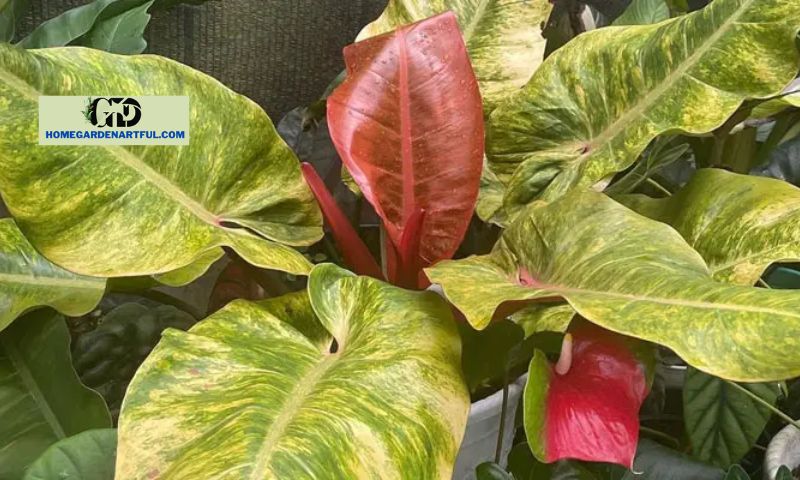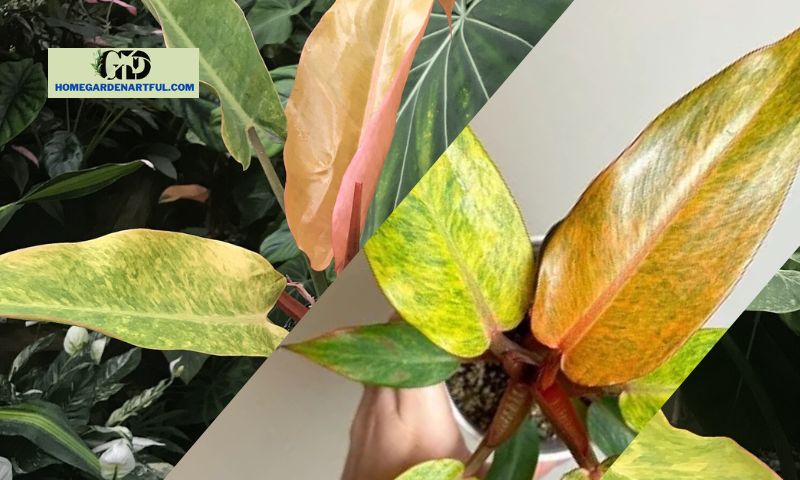This plant is a hybrid, which is why it is occasionally referred to as Philodendron ‘Orange Hybrid’. As they mature, the mottled orange hue of their young leaves will fade to reveal a speckled green color with gold sparkles.
How to Grow and Take Care of Philodendron Orange Marmalade is shown here! At homegardenartful.com, learn how to grow magnificent foliage that will fascinate any indoor or outdoor location by learning the appropriate conditions, watering strategies, and trimming techniques.
Information about Philodendron Orange Marmalade

The Araceae family, also referred to as the Aroid family, includes the Philodendron Orange Marmalade. Plant lovers adore this tropical plant for its eye-catching beauty and distinctive traits. It is a native of the South American rainforests.
The ‘Orange Marmalade’ sticks out among other houseplants thanks to its colorful foliage. Its huge, heart-shaped leaves have a stunning combination of yellow, orange, and green tones that remind one of a mouthwatering marmalade. The glossy texture of the leaves gives them an extra element of elegance to their attractiveness.
Orange Philodendron Depending on the amount of light it receives, marmalade can vary the color of its leaves. The leaves exhibit beautiful orange and yellow tones when they are exposed to strong indirect light. The foliage may turn green in low light circumstances to adapt to its surroundings.
Philodendron Orange Marmalade Propagation from Cuttings
These steps can be used to propagate Philodendron Orange Marmalade by stem cutting:
- Using a sharp, sterilized knife or pruners, cleanly cut a healthy stem from the Philodendron Orange Marmalade plant just below a node.
- Leave a few leaves at the top intact and remove any lower leaves as well as nodes along the stem.
- To hasten root formation, add a rooting hormone to the cut end of the stem.
- A tiny pot should be filled with wet, well-draining soil or a suitable rooting media, such as perlite or vermiculite.
- Create a planting hole in the ground, then place the stem’s cut end inside while making sure it is firmly in place.
- Place the potted cutting away from direct sunlight in a warm, well-lit area.
- Maintain constant soil moisture levels, but refrain from overwatering since this might cause rot.
Propagation Advice: To help conserve moisture and encourage good roots, you can wrap the potted cutting in a plastic bag or create the illusion of a little greenhouse using a clear plastic dome. After the cutting has established its roots and new growth, move it into a larger container or the appropriate place.
The ideal container for philodendron orange marmalade

The growing requirements and habits of your Philodendron Orange Marmalade should be taken into account while choosing a pot. Select a pot for your philodendron plant that can hold its existing root system for best growth. For starters, a container with a diameter of 4-6 inches (10–15 cm) works well for young plants.
Depending on how wide it spreads, progressively re-pot the plant as it grows older into a pot that is one size larger than the original one.
Features of Philodendron Orange Marmalade
This plant can tolerate extended periods of dryness and is particularly drought-tolerant. It’s crucial to let the soil completely dry out in between waterings because too much moisture can destroy the roots.
Air filtration
It is a fantastic plant for cleaning the air as well. It removes dangerous poisons and pollutants, making it a fantastic option for people with allergies or asthma.
Maintenance
Regular leaf pruning is necessary to keep your plant looking its best. This will encourage fresh development and stop the plant from getting out of control. To promote healthy growth, you can fertilize your plant every few months.
Toxicity
It is dangerous and can make you throw up, have diarrhea, and feel sick to your stomach. It’s crucial to get medical help right away if you think your plant has been eaten.
Dormancy
The winter months are when this plant goes into dormancy. The leaves will start to yellow and fall off around this time. This is typical and shouldn’t raise any red flags. In the spring, the plant will start to produce new leaves.
How to Grow Philodendron Orange Marmalade

Sunlight
This Philodendron flourishes in direct, bright light. Put it in a location that receives all-day, mild, indirect sunshine or close to a window with filtered light.
Direct sunlight should be avoided since it can burn the leaves. The plant’s vivid foliage should be kept in an area with regular, moderate lighting.
Provide your Philodendron Orange Marmalade with well-draining soil. Peat moss, perlite, and a premium potting mix work nicely together. This mixture guarantees appropriate moisture absorption without soaking the roots.
In order to avoid root rot and keep plants healthy, proper drainage is crucial.
Watering
When the top inch (2.5 cm) of the soil feels dry to the touch, water your Philodendron Orange Marmalade thoroughly. Because this plant enjoys slightly damp but not soggy circumstances, make sure that any extra water drains out of the pot.
To avoid root rot, avoid overwatering. Depending on the climate and the plant’s needs for moisture, alter the frequency of watering, always allowing the soil to partially dry out between applications.
Temperature and Humidity
The ideal temperature range for Philodendron Orange Marmalade is 65 to 85 degrees Fahrenheit (18 to 29 degrees Celsius). Keep it out of drafts and harsh temperature changes.
This plant thrives under conditions similar to its native rainforest habitat of moderate to high humidity. Consider using a humidifier, setting the pot on a tray with stones and water, or regularly spraying the leaves if the air in your home is dry. A sufficient humidity level promotes healthy growth and reduces leaf oxidation.
Philodendron Orange Marmalade Care
Fertilizer
During the growing season (spring and summer), feed your Philodendron Orange Marmalade with a regulated, water-soluble houseplant fertilizer to encourage healthy growth. Apply the fertilizer every 4-6 weeks after diluting it to half the recommended dosage.
Pruning
Regular pruning encourages new growth while maintaining the size and shape of your Philodendron Orange Marmalade. Make use of clean, sterile pruning shears to remove any yellowed, damaged, or lanky leaves. In order to promote branching and denser foliage, you can also trim back overgrown vines.
To reduce the risk of pests or diseases, remove any dead or rotting plant matter.
Diseases and Pests
Orange Philodendron Although marmalade is usually resistant to pests and illnesses, it is still crucial to keep an eye on things and take immediate action if anything goes wrong.
Neem oil or insecticidal soap should be used to treat infestations, being sure to completely cover both sides of the leaves. To avoid fungal infections such as root rot or leaf spot, maintain proper airflow and refrain from overwatering.
If needed, use fungicides created especially for indoor plants while carefully following the directions. Check the plant frequently for any signs of pests or illnesses, and act appropriately if any are found.
How to Repot Orange Marmalade Philodendrons
Repotting is necessary if your plant is beginning to outgrow its container. To repot your plant, adhere to these steps:
- Select a pot that is somewhat larger than the last one and a potting mixture that drains effectively.
- Remove the plant from its present pot with care.
- Place it in the new pot after gently loosening the roots.
- Potting soil should be used to encircle the roots.
- Place in an area with bright, indirect light after fully watering.
Common Questions Regarding Philodendron Orange Marmalade
Is Orange Marmalade Philodendron a rare plant?
Philodendron Orange Marmalade is a very uncommon plant. There are only a few dozen known examples in existence, and they are all found in South American tropical jungles. If you are fortunate enough to come across one, the ideal environment for it is a glass terrarium with lots of humidity and indirect light.
Is Orange Marmalade from Philodendrons poisonous?
Yes, eating this plant will make you sick. Pilosine, a compound found in this plant, is poisonous to both humans and animals. Constipation, vomiting, and nausea are signs of pilosine poisoning. Severe cases might result in liver damage or even death. If you think someone may have consumed this plant, please contact poison control right away or go to the hospital.
Conclusion
Overall, anyone wanting something unique would love the Philodendron Orange Marmalade. It is the ideal addition to any house thanks to its distinctive hue and carefree spirit. This philodendron is unquestionably something to think about if you’re searching for a plant that will stand out in your collection.


